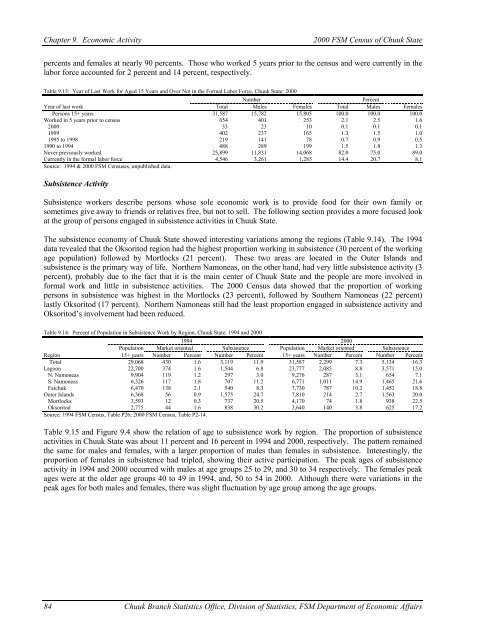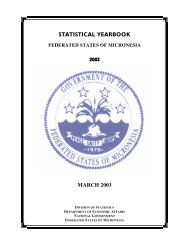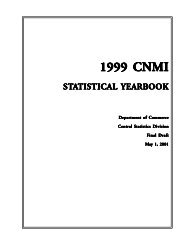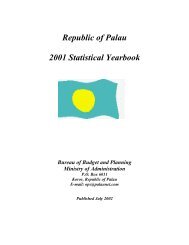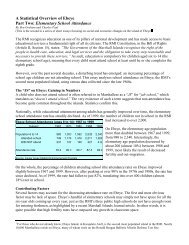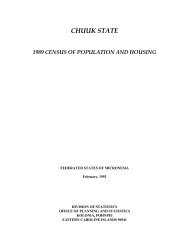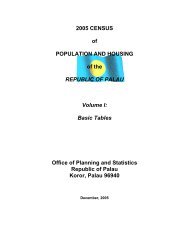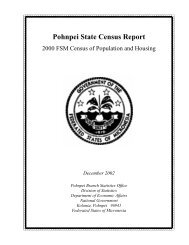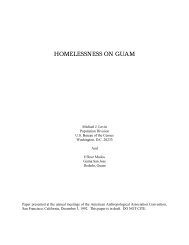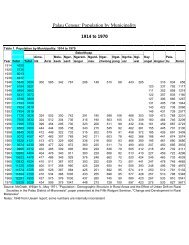Chuuk State Census Report - pacificweb.org
Chuuk State Census Report - pacificweb.org
Chuuk State Census Report - pacificweb.org
You also want an ePaper? Increase the reach of your titles
YUMPU automatically turns print PDFs into web optimized ePapers that Google loves.
Chapter 9. Economic Activity2000 FSM <strong>Census</strong> of <strong>Chuuk</strong> <strong>State</strong>percents and females at nearly 90 percents. Those who worked 5 years prior to the census and were currently in thelabor force accounted for 2 percent and 14 percent, respectively.Table 9.13: Year of Last Work for Aged 15 Years and Over Not in the Formal Labor Force, <strong>Chuuk</strong> <strong>State</strong>: 2000NumberPercentYear of last work Total Males Females Total Males FemalesPersons 15+ years 31,587 15,782 15,805 100.0 100.0 100.0Worked in 5 years prior to census 654 401 253 2.1 2.5 1.62000 33 23 10 0.1 0.1 0.11999 402 237 165 1.3 1.5 1.01995 to 1998 219 141 78 0.7 0.9 0.51990 to 1994 488 289 199 1.5 1.8 1.3Never previously worked 25,899 11,831 14,068 82.0 75.0 89.0Currently in the formal labor force 4,546 3,261 1,285 14.4 20.7 8.1Source: 1994 & 2000 FSM <strong>Census</strong>es, unpublished data.Subsistence ActivitySubsistence workers describe persons whose sole economic work is to provide food for their own family orsometimes give away to friends or relatives free, but not to sell. The following section provides a more focused lookat the group of persons engaged in subsistence activities in <strong>Chuuk</strong> <strong>State</strong>.The subsistence economy of <strong>Chuuk</strong> <strong>State</strong> showed interesting variations among the regions (Table 9.14). The 1994data revealed that the Oksoritod region had the highest proportion working in subsistence (30 percent of the workingage population) followed by Mortlocks (21 percent). These two areas are located in the Outer Islands andsubsistence is the primary way of life. Northern Namoneas, on the other hand, had very little subsistence activity (3percent), probably due to the fact that it is the main center of <strong>Chuuk</strong> <strong>State</strong> and the people are more involved informal work and little in subsistence activities. The 2000 <strong>Census</strong> data showed that the proportion of workingpersons in subsistence was highest in the Mortlocks (23 percent), followed by Southern Namoneas (22 percent)lastly Oksoritod (17 percent). Northern Namoneas still had the least proportion engaged in subsistence activity andOksoritod’s involvement had been reduced.Table 9.14: Percent of Population in Subsistence Work by Region, <strong>Chuuk</strong> <strong>State</strong>: 1994 and 20001994 2000Population Market oriented Subsistence Population Market oriented SubsistenceRegion 15+ years Number Percent Number Percent 15+ years Number Percent Number PercentTotal 29,068 430 1.6 3,119 11.9 31,587 2,299 7.3 5,134 16.3Lagoon 22,700 374 1.6 1,544 6.8 23,777 2,085 8.8 3,571 15.0N. Namoneas 9,904 119 1.2 297 3.0 9,276 287 3.1 654 7.1S. Namoneas 6,326 117 1.8 707 11.2 6,771 1,011 14.9 1,465 21.6Faichuk 6,470 138 2.1 540 8.3 7,730 787 10.2 1,452 18.8Outer Islands 6,368 56 0.9 1,575 24.7 7,810 214 2.7 1,563 20.0Mortlocks 3,593 12 0.3 737 20.5 4,170 74 1.8 938 22.5Oksoritod 2,775 44 1.6 838 30.2 3,640 140 3.8 625 17.2Source: 1994 FSM <strong>Census</strong>, Table P26; 2000 FSM <strong>Census</strong>, Table P2-14.Table 9.15 and Figure 9.4 show the relation of age to subsistence work by region. The proportion of subsistenceactivities in <strong>Chuuk</strong> <strong>State</strong> was about 11 percent and 16 percent in 1994 and 2000, respectively. The pattern remainedthe same for males and females, with a larger proportion of males than females in subsistence. Interestingly, theproportion of females in subsistence had tripled, showing their active participation. The peak ages of subsistenceactivity in 1994 and 2000 occurred with males at age groups 25 to 29, and 30 to 34 respectively. The females peakages were at the older age groups 40 to 49 in 1994, and, 50 to 54 in 2000. Although there were variations in thepeak ages for both males and females, there was slight fluctuation by age group among the age groups.84 <strong>Chuuk</strong> Branch Statistics Office, Division of Statistics, FSM Department of Economic Affairs


